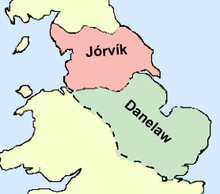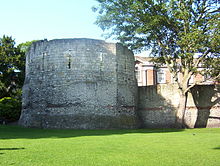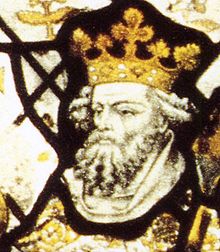- Oslac of York
-
Oslac of York Title Ealdorman of York (c. 966–975) Oslac (fl. 966–975) is regarded as the first ealdorman (or earl) of York and its dependent territories. These included but may not have been limited to the southern half of Northumbria. His background is obscure because of poor source documentation. The latter has facilitated disagreement amongst historians regarding his family and ethnicity.
It is believed that he took over the position of ealdorman of York in 966, holding the position until his downfall in 975. He may have been the first ealdorman of southern—as opposed to a united—Northumbria, though an alternative tradition puts the division of Northumbria into two ealdormanries after his death. Little is known of his career as ealdorman, except for a legend that he escorted the Scottish king Cináed mac Maíl Coluim to the English royal court, and that he was expelled from England in 975. His life is unattested after this. He had one known son, but it is not clear if that son ever succeeded him.
Contents
Origins
Oslac's origins are unclear and no specific relationship with any previous known figure can be established from available sources. Oslac's name suggests to some historians that he was a Norseman. Susan Whitelock points out that the name Oslac is often an anglicisation of the Old Scandinavian name Áslákr,[1] while the writers of the Biographical Dictionary of Dark Age Britain entry on Oslac comment that the name suggests an origin in the Danelaw, a suggestion supported by the fact that Thored, Oslac's son, held lands in Cambridgeshire.[2]
On the other hand Oslac is also a genuine English name, and the common Os element Oslac's name shared with the name of Osulf of Bamburgh, previous ealdorman of York, points to a connection with the Bamburgh family of the English far north.[3]
Accession
The Anglo-Saxon Chronicle recorded for the year 966 that Thored, son of Gunnar, raided Westmorland and that Oslac "took the ealdormanship".[4] Some historians take this to mean that Oslac became the "senior ealdorman of all Northumbria, including the territory of the high-reeves of Bamburgh."[5]
Records exist of Oslac witnessing charters as early as 963; this may mean he was ealdorman by 963, and would imply the death or deposition of his predecessor Osulf.[6] Some of these charters are problematic as source documents, having been recorded only in later cartularlies; there is thus a possibility of interference in their transmission. Moreover, a charter dated 966 of a grant by dux Thored is witnessed by Oslac minister (i.e. "thegn"), suggesting that Oslac had not acceded to the ealdormanship of York before 966.[7]
Division of Northumbria
De primo Saxonum adventu, an 11th- or 12th-century compilation from earlier sources, claims that after the death of Osulf Northumbria was divided into two parts: Eadulf Evil-child receiving the lands between the Firth of Forth and the River Tees and Oslac receiving the lands between the Humber Estuary and the Tees.[8]
According to John of Wallingford, King Edgar made this division during a council at York, in order to prevent the whole area becoming the inheritance of one man.[9] The Historia Regum claims that such a division took place not in Oslac's time but Osulf's, and that the division line was the River Tyne rather than Tees; historian Dorothy Whitelock considered this to be apocryphal.[10]
Career
Oslac frequently attested charters of King Edgar the Peaceable, indicating that Oslac enjoyed some position of trust at court.[11]
De primo Saxonum adventu claims that Oslac, along with Eadulf of Bamburgh and Ælfsige Bishop of Chester-le-Street, escorted the Scottish king Cináed mac Maíl Coluim to the Wessex-based Edgar:
The two earls [Oslac and Eadwulf] along with Ælfsige, who was bishop of St Cuthbert [968—90], conducted Cinaed to king Edgar. And when he had done homage to him, king Edgar gave him Lothian; and with great honour sent him back to his own.[12]
This must have occurred — if it happened at all — between 968 and 975, i.e. between Ælfsige becoming bishop and Edgar dying.[13] Richard Fletcher dated it to 973.[14]
The historian Geoffrey Barrow believed this to mark the beginning of Scottish control over all the lands between the River Tweed and Firth of Forth (defining "Lothian" in this manner),[15] though another historian, Alex Woolf, has suggested that the part about Lothian may have been fabricated later to give credence to the claim that the Scottish kings owed homage for lands in Lothian.[13]
Downfall and legacy
In 975, not long after the death of King Edgar, Oslac was banished from England. No reason is given by the Anglo-Saxon Chronicle's report of his expulsion.[16] Version C of the Anglo-Saxon Chronicle describes the events thus:
The valiant Oslac was driven from the country, over the tossing waves, the gannet's bath, the tumult of the waters, the homeland of the whale; a grey-haired man, wise and skilled in speech, he was bereft of his lands[17]
The historian Richard Fletcher guesses that Oslac's downfall may have been the result of opposing the succession of Edward the Martyr.[18]
Oslac is said by the Historia Eliensis to have had a son named Thorth, that is, Thored.[19] His successor was indeed a man named Thored, but it is not clear whether this was Thored Oslac's son or Thored son of Gunner; historians tend to favour the idea that Thored the successor was son of Gunner.[20]
The Gesta Herwardi tells us that his great-great granddaughter, Aedeva (Edith), was Hereward's mother.[21]
Regnal titles Preceded by
Osulf of BamburghEaldorman of York
c. 966–975Succeeded by
ThoredNotes
- ^ Whitelock, "Dealings of the Kings", p. 79
- ^ Whitelock, Dealings of the Kings, pp. 78—9; Williams, Smyth and Kirby, Biographical Dictionary, s.v. "Oslac ealdorman 963—75", p. 194
- ^ Fletcher, Bloodfeud, p. 44
- ^ ASC D, etc, s.a. 966
- ^ William, Smyth & Kirby, Biographical Dictionary, s.v. "Oslac, ealdorman 963—75", p. 194
- ^ Fletcher, Bloodfeud, p. 44; Rollason, Northumbria, pp. 266—7
- ^ Whitelock, "Dealings of the Kings", p. 78
- ^ Whitelock, "Dealings of the Kings", p. 77; Woolf, Pictland to Alba, p. 211; Arnold (ed.), Symeonis Monachi Opera Omnia, vol. ii, p. 382; Anderson, Scottish Annals, p. 77
- ^ Whitelock, "Dealings of the Kings", p. 77
- ^ Whitelock, "Dealings of the Kings", pp. 77—8
- ^ Fletcher, Bloodfeud, p. 44; Oslac 7, PASE
- ^ Trans. Woolf, Pictland to Alba, p. 211; Latin text printed in Arnold (ed.), Symeonis Monachi Opera Omnia, vol. ii, p. 382
- ^ a b Woolf, Pictland to Alba, p. 211
- ^ Fletcher, Bloodfeud, p. 56
- ^ Barrow, "Anglo-Scottish Border", pp. 121—5
- ^ ASC MS D, E, s.a. 975; Oslac 7, PASE;
- ^ ASC MS C, s.a. 975 (c/f ASC MS B s.a. 975), translated Fletcher, Bloodfeud, p. 44; see also William, Smyth & Kirby, Biographical Dictionary, s.v. "Oslac, ealdorman 963—75", p. 194
- ^ Fletcher, Bloodfeud, p. 45
- ^ Fletcher, Bloodfeud, pp. 70—1; Whitelock, "Dealings of the Kings", pp. 77—8
- ^ Fletcher, Bloodfeud, p. 71; Whitelock, "Dealings of the Kings", pp. 77—8; Woolf, Pictland to Alba, p. 211; but compare Williams, Smyth and Kirby, Biographical Dictionary, s.v. "Oslac ealdorman 963—75", p. 194
- ^ Gesta Herwardi Chapter 2 "... et mater Aediva trinepta Oslaci ducis ..."
References
- "Oslac 7", Prosopography of Anglo-Saxon England, The Prosopography of Anglo-Saxon England Database Project, 2005, http://www.pase.ac.uk/pase/apps/DisplayPerson.jsp?personKey=7707, retrieved 2009-01-19
- Anderson, Alan Orr, ed. (1908), Scottish Annals from English Chroniclers A.D. 500 to 1286 (1991 revised & corrected ed.), Stamford: Paul Watkins, ISBN 1-871615-45-3
- Arnold, Thomas, ed. (1882–85), Symeonis Monachi Opera Omnia, Rerum Britannicarum Medii Ævi Scriptores, or, Chronicles and Memorials of Great Britain and Ireland during the Middle Ages; vol. 75 (2 vols.), London: Longman
- Fletcher, Richard (2003), Bloodfeud: Murder and Revenge in Anglo-Saxon England, London: Penguin Books, ISBN 0-14-028692-6
- Kapelle, William E. (1979), The Norman Conquest of the North: The Region and Its Transformation, 1000–1135, London: Croom Helm Ltd, ISBN 0-7099-0040-6
- Rollason, David (2003), Northumbria, 500—1100: Creation and Destruction of a Kingdom, Cambridge: Cambridge University Press, ISBN 0-521-04102-3
- Seebohm, Frederic (1902), Tribal Custom in Anglo-Saxon Law : Being an Essay Supplemental to: (1) The English Village Community, (2) The Tribal System in Wales, London: Longmans, Green & Co.
- Whitelock, Dorothy (1959), "The Dealings of the Kings of England with Northumbria", in Clemoes, Peter, The Anglo-Saxons: Studies in some Aspects of their History and Culture presented to Bruce Dickins, London: Bowes & Bowes, pp. 70–88
- Williams, Ann; Smyth, Alfred P.; Kirby, D. P. (1991), A Biographical Dictionary of Dark Age Britain: England, Scotland and Wales, c.500–c.1050, London: Seaby, ISBN 1-85264-047-2
- Woolf, Alex (2007), From Pictland to Alba, 789–1070, The New Edinburgh History of Scotland, Edinburgh: Edinburgh University Press, ISBN 978-0-7486-1234-5
Categories:- Earls and ealdormen of York
- 10th-century rulers in Europe
Wikimedia Foundation. 2010.



